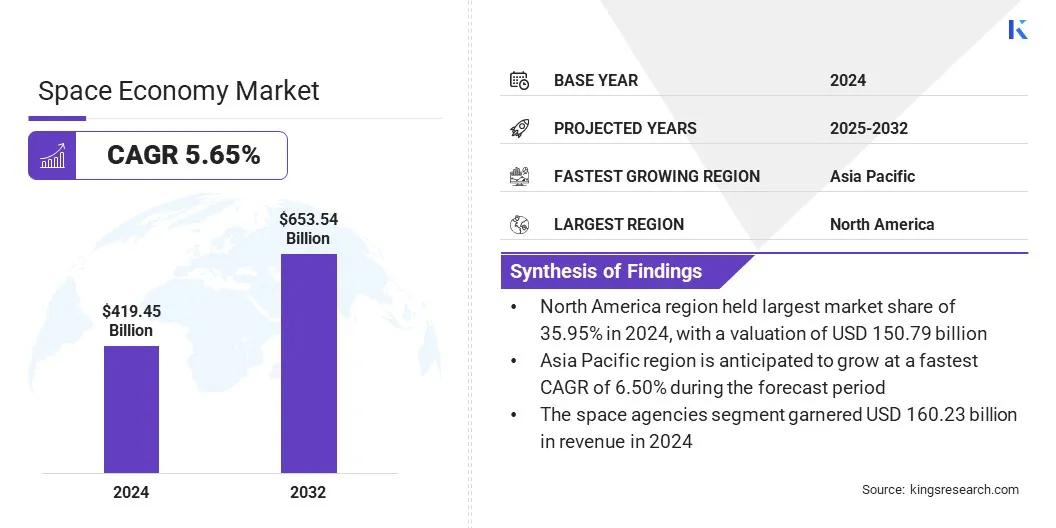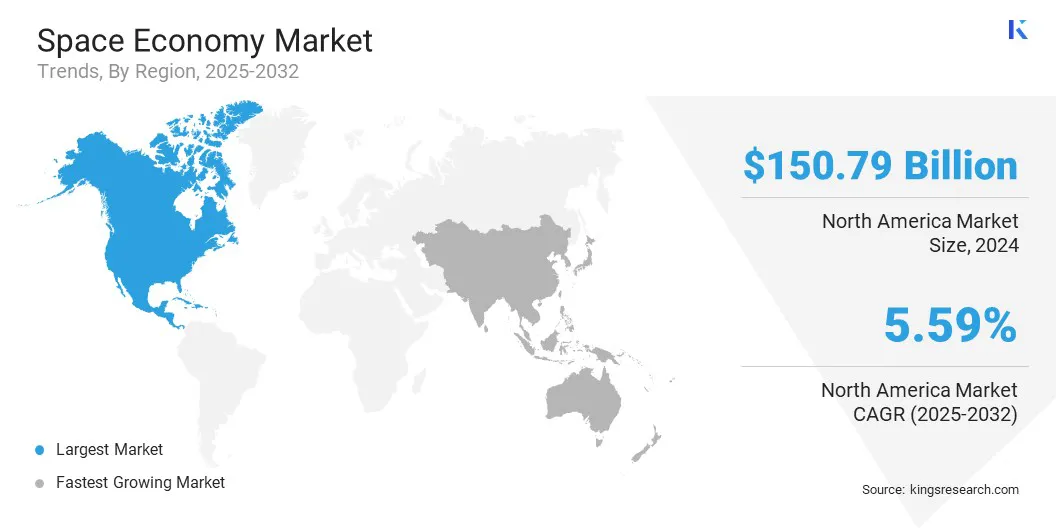buyNow
Space Economy Market
Space Economy Market Size, Share, Growth & Industry Analysis, By Application (Communication, Earth Observation, Navigation & Mapping, Space Exploration, Others), By End Use (Commercial, Government & Defense, Academic & Research Institutions, Space Agencies), and Regional Analysis, 2025-2032
pages: 140 | baseYear: 2024 | release: July 2025 | author: Versha V.
Market Definition
The space economy encompasses all activities related to the development, production, deployment, and operation of technologies and infrastructure that support access to and utilization of outer space. It includes industries involved in satellite manufacturing, launch systems, onboard payloads, in-orbit solutions, mission operations, and data services.
The global space economy market size was valued at USD 419.45 billion in 2024 and is projected to grow from USD 442.18 billion in 2025 to USD 653.54 billion by 2032, exhibiting a CAGR of 5.65% during the forecast period.
Market growth is propelled by increasing efforts to make space technologies more accessible across commercial, academic, and government sectors. The market is also witnessing a shift toward real-time imaging and Edge-AI in satellite systems, which enables faster data processing and decision-making.
Key Highlights:
- The space economy industry size was recorded at USD 419.45 billion in 2024.
- The market is projected to grow at a CAGR of 5.65% from 2025 to 2032.
- North America held a market share of 35.95% in 2024, with a valuation of USD 150.79 billion.
- The communication segment garnered USD 117.77 billion in revenue in 2024.
- The space agencies segment is expected to reach USD 252.01 billion by 2032.
- Asia Pacific is anticipated to grow at a CAGR of 6.50% over the forecast period.
Major companies operating in the space economy market are Planet Labs PBC., Rocket Lab USA, Thales Alenia Space, Maxar Technologies, Arianespace, BAE Systems, Blue Origin, Airbus, United Launch Alliance, LLC., Lockheed Martin Corporation, Northrop Grumman, BlackSky, SpaceX, Safran Group, and MITSUBISHI HEAVY INDUSTRIES, LTD.

Space Economy Market Report Scope
|
Segmentation |
Details |
|
By Application |
Communication, Earth Observation, Navigation & Mapping, Space Exploration, Others |
|
By End Use |
Commercial, Government & Defense, Academic & Research Institutions, Space Agencies |
|
By Region |
North America: U.S., Canada, Mexico |
|
Europe: France, UK, Spain, Germany, Italy, Russia, Rest of Europe | |
|
Asia-Pacific: China, Japan, India, Australia, ASEAN, South Korea, Rest of Asia-Pacific | |
|
Middle East & Africa: Turkey, U.A.E., Saudi Arabia, South Africa, Rest of Middle East & Africa | |
|
South America: Brazil, Argentina, Rest of South America |
Space Economy Market Regional Analysis
Based on region, the market has been classified into North America, Europe, Asia Pacific, Middle East & Africa, and South America.
North America space economy market share stood at 35.95% in 2024, valued at USD 150.79 billion. This dominance is reinforced by the strong presence of government space programs and sustained funding for advanced satellite systems and launch capabilities.
Moreover, the long-term public and private sector initiatives have supported innovation in reusable launch systems, inter-satellite communication, and AI-based space applications. These efforts have strengthened the region’s position in both commercial and governmental segments.

The Asia-Pacific space economy industry is poised to grow at a CAGR of 6.50% over the forecast period. This growth is boosted by increasing partnerships and technological advancements across emerging space programs. Countries such as China, India, Japan, and South Korea are forming collaborations with commercial players to develop cost-effective satellite platforms and high-capacity launch systems.
Regional companies are investing in next-generation imaging, navigation, and communication technologies to support growing demand across civil, defense, and scientific sectors. This approach is expanding regional capabilities and accelerating participation in the global space economy.
- In July 2025, Space TS and Synergy Quantum signed a memorandum of understanding to co-develop India’s first indigenous quantum-secure satellite. The partnership focuses on building secure ground infrastructure, post-quantum encrypted satellite systems, and autonomous mission control technologies.
Space Economy Market Overview
Market expansion is propelled by the development of two-way laser communication between satellites in space. This technology allows secure, high-speed data exchange without depending on ground infrastructure. The two-way laser communication improves network reliability and reduces latency across satellite constellations.
The capability to maintain continuous communication in remote or obstructed regions increases the efficiency of space-based data services. This advancement supports the growing need for uninterrupted global connectivity across sectors.
- In March 2025, Spire Global, Inc. successfully established a two-way optical link between two satellites in orbit. The achievement demonstrated the company’s optical inter-satellite link payload technology, which enables secure, high-speed data transmission between satellites separated by up to 5,000 kilometers. The technology is designed to improve data security, increase transmission speed, and reduce latency for applications such as global communications, weather forecasting, and remote sensing.
Market Driver
Growing Demand for Broader Accessibility to Space Technologies
The growth of the space economy market is driven by the growing demand for broader accessibility to space technologies across industries and geographies. Governments and private organizations are investing in affordable launch solutions, small satellite platforms, and open-access space data. These efforts reduce entry barriers for startups, academic institutions, and developing countries.
Increased access to satellite-based services supports applications in communication, environmental monitoring, and research, boosting technology adoption and expanding operational activities.
- In May 2024, the European Patent Office (EPO) launched atechnology platform to improve access to space-related patent information for researchers, entrepreneurs, and policymakers. The platform enables precise navigation of patent data and supports innovation in cosmonautics and space observation. Additionally, the EPO updated its Deep Tech Finder to help users identify investment-ready space startups and published a new patent insight report on propulsion systems for space.
Market Challenge
High Launch Costs
A major challenge hindering the expansion of the space economy market is the high cost of satellite launches and infrastructure development. These expenses limit participation from startups and smaller companies, slowing innovation and reducing competition. This issue affects the expansion of commercial applications and delays new service deployment.
To address this challenge, companies are using shared launch models and rideshare missions to lower per-unit launch costs. Governments are also supporting new entrants through funding programs and public-private partnerships, helping them access space more affordably and efficiently.
Market Trend
Shift Toward Real-Time Imaging and Edge-AI in Satellite Systems
The space economy market is witnessing a growing shift toward satellite cameras equipped with real-time image capture and onboard edge-AI processing. This trend supports faster data analysis directly in orbit, reducing the need to transmit large volumes of raw data back to Earth.
It enhances the efficiency of Earth observation, disaster monitoring, and defense applications by enabling near-instantaneous insights. The integration of AI at the satellite level also lowers latency and improves autonomous decision-making, making space-based systems more responsive and operationally valuable across sectors.
- In September 2024, Ubotica launched its SPACE:AI-powered camera, CogniSAT-NEI, designed for in-orbit imaging and autonomous satellite operations. The camera features real-time image capture and onboard Edge-AI processing for applications such as space debris detection, situational awareness, autonomous navigation, and satellite maintenance.
Market Segmentation
- By Application (Communication, Earth Observation, Navigation & Mapping, Space Exploration, and Others): The communication segment earned USD 117.77 billion in 2024, primarily due to rising demand for satellite-based internet, broadcasting, and mobile connectivity across remote regions.
- By End Use (Commercial, Government & Defense, Academic & Research Institutions, and Space Agencies): The space agencies segment held a share of 38.20% in 2024, fueled by consistent investments in deep space missions, satellite programs, and international space collaborations.
Regulatory Frameworks
- In the U.S., the Federal Aviation Administration (FAA), Federal Communications Commission (FCC), and National Oceanic and Atmospheric Administration (NOAA) regulate commercial space launches, satellite communications, and remote sensing activities under the Commercial Space Launch Act and related laws.
- In Europe, the European Space Agency (ESA) coordinates with national space authorities, while the European Union Agency for the Space Programme (EUSPA) oversees the implementation and operation of Galileo and Copernicus under EU space law.
Competitive Landscape
Key players in the space economy industry are focusing on strategic collaborations to expand capabilities and access new markets. Companies are entering partnerships with satellite operators, telecom firms, and defense organizations to co-develop advanced communication and Earth observation systems. Several players have signed MoUs with national space agencies to jointly execute exploration missions and technology demonstrations.
Joint ventures are being formed to develop next-generation launch vehicles, space habitats, and in-orbit servicing platforms. Many organizations are aligning with academic and research institutions to accelerate innovation in satellite design, propulsion, and AI-driven space applications. These strategies are enabling market participants to share risk, pool resources, and strengthen their positions in both commercial and government segments.
- In July 2025, Warpspace and Sidus Space signed a memorandum of understanding to develop advanced optical space communication technologies. The partnership aims to integrate Sidus Space’s mission expertise with Warpspace’s WarpHub InterSat system to deliver high-performance solutions for next-generation satellite communications and mission operations.
Key Companies in Space Economy Market:
- Planet Labs PBC.
- Rocket Lab USA
- Thales Alenia Space
- Maxar Technologies
- Arianespace
- BAE Systems
- Blue Origin
- Airbus
- United Launch Alliance, LLC.
- Lockheed Martin Corporation
- Northrop Grumman
- BlackSky
- SpaceX
- Safran Group
- MITSUBISHI HEAVY INDUSTRIES, LTD.
Recent Developments (Product Launch)
- In July 2025, Arianespace deployed the CO3D and MicroCarb satellites using a Vega C rocket launched from Europe’s Spaceport in French Guiana. The mission successfully inserted Airbus Defence and Space’s four-satellite CO3D constellation and CNES’s MicroCarb satellite into Sun-synchronous orbits.
- In February 2025, Redwire Corporation deployed its Sentinel camera technology on Intuitive Machines’ second commercial lunar mission, IM-2, via the Nova-C lander, Athena. The SentinelCam, part of Redwire’s established product line, features terrain-relative navigation and hazard detection cameras to support precision landing and movement tracking on the Moon’s surface.
freqAskQues
